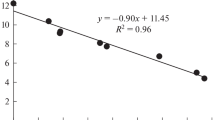Summary
The problems connected with soil testing on calcareous soils are discussed.
It is pointed out that in calcareous soils pH differences in the range of pH 7.0–8.5 are meaningless unless the measurements are made under standard conditions with respect to CO2 and Ca-ion concentration. A knowledge of CO2 variations under field conditions is considered essential for proper ecological interpretation of the reaction of calcareous soils.
It is stressed that the lime fraction in calcareous soils has its own inherent particle size distribution. Information regarding this fraction should therefore be included in the mechanical analysis of the soils. A method for the determination of the size frequency distribution of the CaCO3 is outlined.
A simple method for the determination of the reactivity of the lime is described and the various conditions affecting the reaction are discussed. The method gives the relative surface area of the lime by oxalate adsorption and is used for the diagnosis of susceptibility to lime-induced chlorosis.
Similar content being viewed by others
References
Averna, V., Ricerche sul calcare attivo del terreno agrario. (Investigation of the active lime content of agricultural soil). Ann. sper. agr.8 n.s., 1373–1392 (1954).
Balks, R. and Wehrmann, O., Vergleichende Löslichkeitsstudien an kohlensauren Kalken (Comparative studies on the solubility of carbonate liming materials). Bodenk. Pflanzenernähr.9–10, 313–321 (1938).
Bjerrum, N., and Gjaldbaek, J. K., Investigation on the factors which determine the reaction of soils. Kgl. Vet. Landboh. Aarskrift 48–91 (1919).
Boischot, P. and Hebert, J., Sur le dosage de calcaire actif des sols par la méthode à l'oxalate d'ammonium. Ann. Agron.17, 521–529 (1947).
Drouineau, G., Dosage rapide du calcaire actif de sols. Ann. Agron.12, 441–450 (1942).
Elphick, B. L., Studies in the use of agricultural limestone. New Zealand J. Sci. Technol.36A, 137–166 (1954).
Hagin, J., The active lime content of soil as a factor in the development of chlorosis. Bull. Research Council Israel2, 138–146 (1952).
Love, K. S. and Whitaker, C. W., Surface area and reactivity of typical agricultural limestones. Agr. Food Chem.2 1268–1272 (1954).
Schofield, R. K. and Taylor, A. W., The measurement of soil pH. Soil Sci. Soc. Amer. Proc.19, 164–167 (1955).
Whitney, R. S., and Gardner, R., The effect of carbon dioxide on soil reaction. Soil Sci.55, 127–141 (1943).
Yaalon, D. H., Calcareous soils of Israel. The amount and particle size distribution of the calcareous material. Israel Exploration J.4, 278–285 (1954).
Yaalon, D. H., Physico-chemical relationship of CaCO3, pH and CO2 in calcareous soils. Trans. Intern. Congr. Soil Sci. Leopoldville2, 356–363 (1954).
Yaalon, D. H., A theoretical and experimental investigation of the effects of saline irrigation water on sodium adsorption and permeability characteristics of calcareous soils. Ph. D. Thesis, Jerusalem (1954).
Author information
Authors and Affiliations
Rights and permissions
About this article
Cite this article
Yaalon, D.H. Problems of soil testing on calcareous soils. Plant Soil 8, 275–288 (1957). https://doi.org/10.1007/BF01666162
Received:
Issue Date:
DOI: https://doi.org/10.1007/BF01666162




